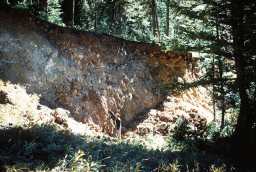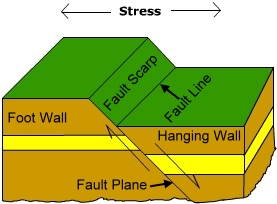FaultingWhen enormous stresses build and push large intact rock masses beyond their yield limit, faulting of the surface is likely to occur. A fault is a fracture along which movement occurs. The plane that extends into the earth and along which slippage occurs is called the fault plane. The fault dip is the angle from horizontal that the fault plane makes. The map direction that the fault takes is called the strike, measured east or west of true north. Generally, two walls are distinguished, the footwall and hanging wall. The hanging wall moves horizontally, vertically, or in both directions relative to the footwall. We identify the hanging and foot walls relative to the fault plane. The hanging wall is above the fault plane while the foot wall is below. The steep face of an exposed block is called the fault scarp. The fault line is the trace of the fault along the surface
Faults can be traced for thousands of kilometers across the surface at tens of kilometers in depth. The sudden slippage of rock masses past one another results in shock waves that we feel as an earthquake. For information about earthquakes see "How Earthquakes Occur" by the USGS.
Figure 15.28 Features of Faults (normal fault
depicted) |


